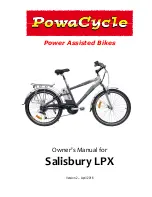
8
•
Owing to a small risk of fire when charging a battery that has become
faulty
, do not leave the battery permanently charging from the mains
supply or charging unsupervised, especially overnight.
•
Only use the charger provided to charge the battery. The charger's
supply voltage must match local voltage.
•
During charging, the battery pack should be located in a stable
position on its side to prevent damage by toppling over.
•
If during charging, storage, or use the battery pack should
overheat or exhibit other abnormality this indicates a fault with
either battery pack or charger. In that case, cut the power supply
immediately and return battery and charger to your vendor's after-
sales-service centre for repair.
•
Do not use the battery to power anything other than the Powacycle
for which it was purchased.
•
Do not disassemble or modify the battery.
•
Do not expose the battery to fire or extreme temperatures.
•
Do not short circuit the battery.
•
Do not drop, and take care to avoid violent impacts.
Do not pierce
the battery case with sharp tools.
•
At end of life always dispose of a defunct battery by returning it to
your dealer, or otherwise at a dedicated waste facility.
•
Keep battery pack and charger out of the reach of children.
Tyres
•
Check the tyres regularly to ensure that the correct pressures are
maintained (pressure range is shown on the sides of the tyres).
•
Do not over-inflate the tyres.
•
There are different types of pumps available for cycles. Ask your
local cycle shop for the one best suited to your needs (do not use a
garage forecourt air hose to inflate your tyres).
Brakes
•
Make sure your brakes are adjusted correctly at all times.
•
Major adjustment (needs tools) can be made at the cable clamp
bolt on the brake arms. Fine tuning the brakes can be done by
twisting the barrel adjusters located where the cables enter the
brake levers.
•
Replace brake blocks when worn.











